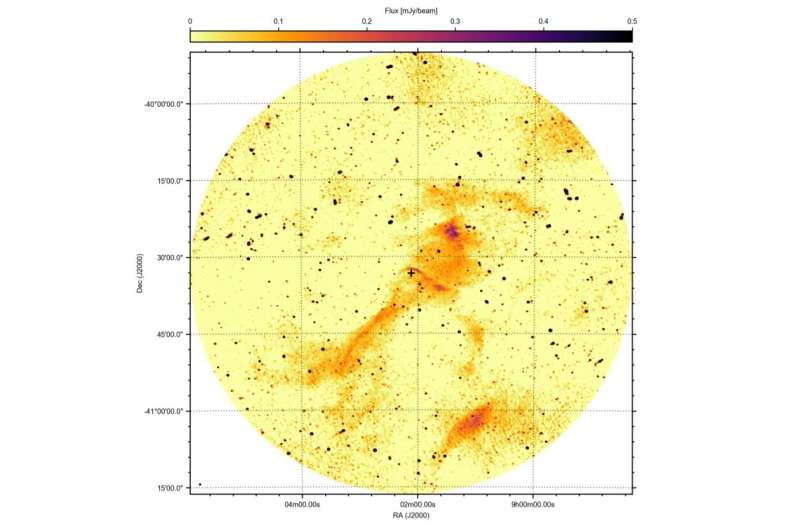November 30, 2021 report
Radio emission detected from the Vela X-1 bow shock

Tomasz Nowakowski
astronomy writer

An international team of astronomers has conducted radio observations of a bow shock in the X-ray binary Vela X-1 using MeerKAT telescope. The observational campaign resulted in the detection of radio emission from this source. The finding is detailed in a paper published November 19 on arXiv.org.
Vela X-1 is a runaway high-mass X-ray binary (HMXB) system, consisting of an accreting neutron star and the supergiant donor HD 77581 in a tight 9-day orbit. HD 77581 launches a strong stellar wind that causes a bow shock as it interacts with the interstellar medium. This makes Vela X-1 one of only two HMXBs known to experience a bow shock.
To date, the bow shock in Vela X-1 has been detected only by narrow-band hydrogen-alpha imaging and by infrared observations. However, now a group of astronomers led by Jakob van den Eijnden of University of Oxford, UK, reports the radio detection of this feature. The discovery was made as part of the ThunderKAT Large Survey Project with MeerKAT, which is aimed at performing radio observations of active, Southern X-ray binaries, cataclysmic variables, supernovae, and gamma-ray bursts.
"Vela X-1 was observed with the MeerKAT telescope on 2020-09-25, 2020-09-27, and 2020-10-11. The telescope's L band (856—1712 MHz; hereafter reported at the central frequency of 1.3 GHz) receivers were used, with the correlator configured to deliver 32,768 channels and 8 second integration time per visibility point. For the three observations there were 59, 61, and 60 antennas used in the array," the researchers explained.
MeerKAT observations detected 1.3-GHz radio emission from the bow shock, what makes it the first radio bow shock identified around an X-ray binary. The peak radio flux density of the entire bow shock was measured to be 270
Written for you by our author —this article is the result of careful human work. We rely on readers like you to keep independent science journalism alive. If this reporting matters to you, please consider a (especially monthly). You'll get an ad-free account as a thank-you.
More information: J. van den Eijnden et al, MeerKAT discovery of radio emission from the Vela X-1 bow shock. arXiv:2111.10159v2 [astro-ph.HE],
© 2021 Science X Network





















